Nachdem wir jahrelang WordPress-Websites erstellt haben, haben wir gelernt, wie wichtig es ist, eine lokale WordPress-Einrichtung auf Ihrem Computer zu haben.
Mit WordPress auf Ihrem persönlichen Rechner können Sie mit neuen Funktionen experimentieren, ohne Ihre Live-Site zu gefährden, tief in die WordPress-Entwicklung eintauchen und sogar ganze Websites erstellen, bevor sie live gehen. Es ist wie eine private Sandbox für alle Ihre WordPress-Projekte.
Als Windows-Benutzer gibt es zahlreiche Möglichkeiten, WordPress lokal einzurichten. Wir haben uns jedoch auf die zwei einfachsten Methoden beschränkt. In dieser Anleitung zeigen wir Ihnen, wie Sie WordPress ganz einfach auf einem Windows-Computer installieren können, unabhängig davon, welche Version Sie verwenden.
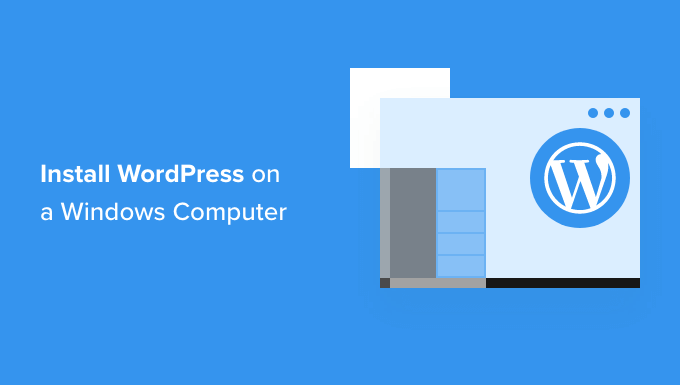
Warum sollten Sie WordPress unter Windows installieren?
Wenn Sie ein Windows-Benutzer sind, dann bietet die lokale Installation von WordPress auf Ihrem Computer mehrere Vorteile.
Eine lokale WordPress-Installation schafft eine Testumgebung, die sich nicht auf Ihre Live-Website auswirkt. Diese Einrichtung, die oft als lokaler Server oder localhost bezeichnet wird, ist Ihr persönlicher Spielplatz für WordPress.
WordPress-Entwickler verwenden regelmäßig lokale Installationen für ihre Arbeit. Zum Beispiel können sie damit mit neuen Plugins oder Themes experimentieren oder die Website vor dem Update auf den Gutenberg-Blockeditor testen.
Aber das ist nicht nur etwas für Profis. Wenn Sie WordPress noch nicht kennen, ist eine lokale Installation perfekt zum Lernen. Sie können Funktionen erkunden, Themes und Plugins testen und frei experimentieren, ohne sich Sorgen machen zu müssen, dass eine Live-Site kaputt geht.
Es ist wichtig zu wissen, dass bei einer lokalen Installation von WordPress unter Windows nur Sie die Website sehen können. Wenn Sie eine öffentliche Website erstellen möchten, benötigen Sie einen Domainnamen und Webhosting.
Technisch gesehen können Sie WordPress unter Windows mit XAMPP installieren, und wir haben bereits eine Anleitung dazu geschrieben.
Wir haben jedoch 2 noch einfachere Methoden als XAMPP gefunden, um eine lokale WordPress-Umgebung einzurichten. Sie eignen sich hervorragend für Anfänger oder Benutzer, die schnell eine lokale Website erstellen müssen. Sie können auf den unten stehenden Link klicken, um zu der jeweiligen Methode zu springen, die Sie interessiert:
Methode 1: WordPress unter Windows mit Studio installieren (schnell und einfach)
Für die erste Methode werden wir Studio verwenden. Dabei handelt es sich um eine lokale WordPress-Software von Automattic, dem Unternehmen, das WordPress.com verwaltet und betreibt, einen Website-Builder, der auf der WordPress-Software basiert.
Wir werden zuerst über diese Methode sprechen, weil sie viel schneller und einfacher zu befolgen ist, was sie perfekt für absolute Anfänger macht.
Zunächst müssen Sie die Website Studio by WordPress.com öffnen. Klicken Sie dann auf die Schaltfläche “Download für Windows”.

Öffnen Sie dann einfach die heruntergeladene Datei, um die Installation zu starten.
Es erscheint nun ein Popup-Fenster, das Ihnen anzeigt, dass die Anwendung installiert wird.
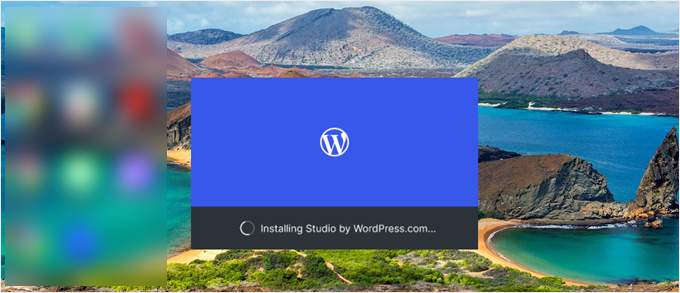
Danach können Sie Ihre erste Website hinzufügen.
Geben Sie dazu einfach den Namen Ihrer neuen lokalen WordPress-Site ein und klicken Sie auf “Site hinzufügen”. Sie können die Website benennen, wie Sie wollen, solange Sie sie leicht identifizieren können.
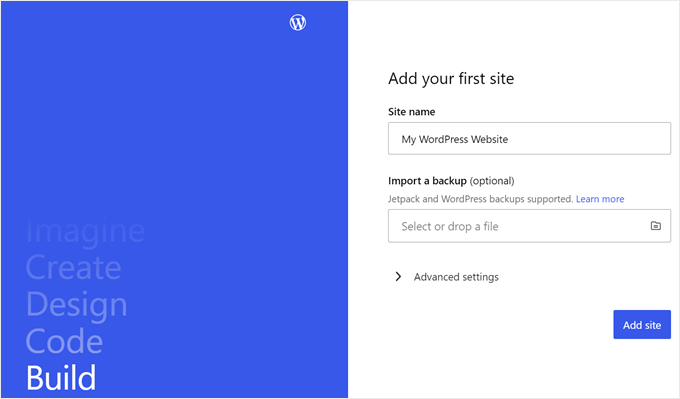
Sie sollten nun das Dashboard Ihrer lokalen WordPress-Website sehen.
Um auf Ihr WordPress-Dashboard zuzugreifen und Ihre Website zu bearbeiten, klicken Sie einfach auf die Schaltfläche “Start” in der oberen rechten Ecke. Dadurch wird Ihre lokale Website für Sie auf Ihrem Computer zugänglich.
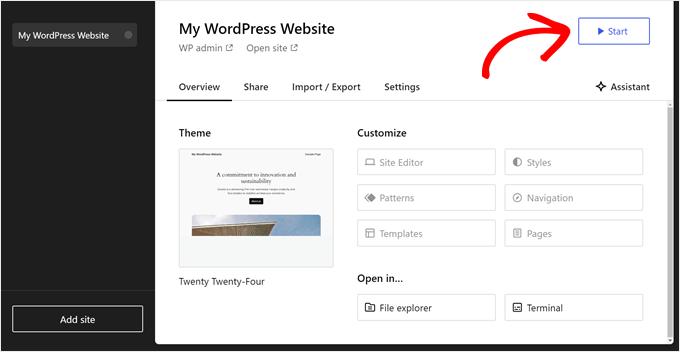
Sobald die Schaltfläche “Start” auf “Läuft” wechselt, können Sie auf den Link “WP Admin” oben links auf der Seite klicken.
Dies bringt Sie zu Ihrer lokalen WordPress-Verwaltungsseite.

Und das war’s dann auch schon mit der Einrichtung. Sehen wir uns nun die anderen Einstellungen an, die beim Aufbau Ihrer lokalen Website erforderlich sein können.
Wie Sie auf der Registerkarte “Übersicht” sehen können, haben Sie direkt vom Studio-Dashboard aus Zugriff auf das Menü des WordPress-Vollseiteneditors. Sie können auch auf “Datei-Explorer” klicken, um die Ordner und Dateien Ihrer WordPress-Website zu öffnen, und auf “Terminal” klicken, um Ihre Website mit WP-CLI zu verwalten.
Wenn Sie zur Registerkarte “Freigeben” wechseln, können Sie sich bei Ihrem WordPress.com-Konto anmelden, Ihre lokale Website klonen und sie auf die Server von WordPress.com hochladen. Dadurch wird die geklonte Website vorübergehend online gestellt, was für die gemeinsame Nutzung von Demoseiten mit Ihren Kunden oder Teammitgliedern nützlich ist.
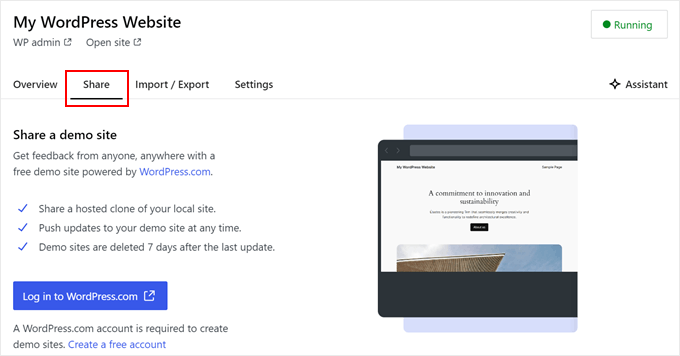
Es kann vorkommen, dass Sie sich direkt über Ihren Browser bei Ihrer lokalen Website anmelden möchten, anstatt Studio zu verwenden. In diesem Fall müssen Sie Ihre wp-admin-Anmeldedaten kennen.
Um sie zu finden, können Sie zur Registerkarte “Einstellungen” wechseln und dort Ihren WordPress-Administrator-Benutzernamen, Ihr Passwort und Ihre Anmelde-URL finden.
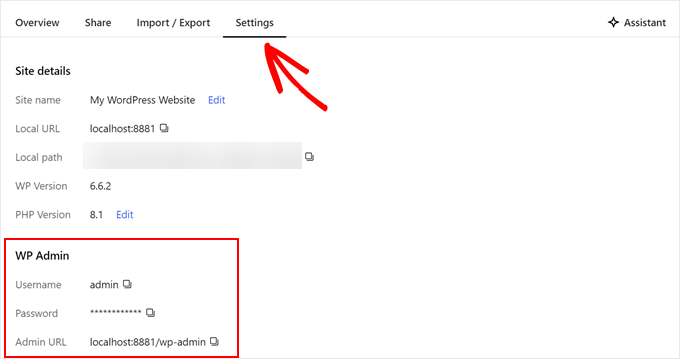
Eine weitere nützliche Funktion von Studio ist der integrierte KI-Chatbot, mit dem Sie kommunizieren können, indem Sie auf die Schaltfläche “Assistent” klicken.
Hier können Sie Studio um Hilfe bei Aufgaben wie der gleichzeitigen Aktualisierung aller Ihrer Plugins, der Aktualisierung Ihrer WordPress-Kernversion oder der Erstellung von Code für einen benutzerdefinierten Block bitten.

Wenn Sie mit der Arbeit an Ihrer lokalen Website fertig sind, bewegen Sie den Mauszeiger einfach über die Schaltfläche “Laufend” in der oberen rechten Ecke, bis dort “Stopp” steht.
Klicken Sie dann auf die Schaltfläche, um die Website zu beenden.

Ein Nachteil von Studio ist, dass Sie die WordPress-Umgebung nicht nach Ihren Wünschen konfigurieren können. Das bedeutet, dass Sie die PHP-Version, den Webserver und die Datenbank verwenden müssen, die für Sie vorausgewählt wurden.
Dies kann ein Nachteil sein, wenn Sie Ihre Website oder Ihr Plugin mit bestimmten Serverkonfigurationen testen müssen.
Wenn Sie mehr Kontrolle über Ihre lokale WordPress-Umgebung benötigen oder Ihr lokales Setup an eine bestimmte Live-Server-Konfiguration anpassen müssen, können Sie die nächste Methode mit Local WP ausprobieren.
Methode 2: WordPress unter Windows mit lokalem WP installieren (besser anpassbar)
Zunächst müssen Sie die Local WP-Software herunterladen und auf Ihrem Windows-Computer installieren. Gehen Sie einfach auf die Local WP-Website und klicken Sie auf die Schaltfläche “Download for Free”.
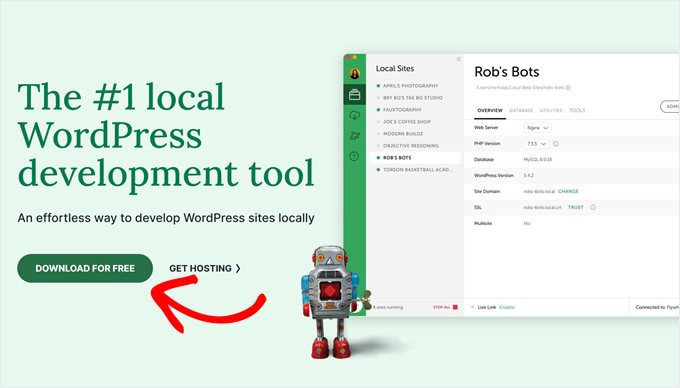
Daraufhin erscheint ein Popup-Fenster, in dem Sie Ihre Plattform auswählen müssen. Wählen Sie “Windows” aus dem Dropdown-Menü.
Als Nächstes können Sie Ihre Daten wie Vor- und Nachname, Arbeits-E-Mail-Adresse und Telefonnummer eingeben, um die Software herunterzuladen.

Nach Eingabe der Daten klicken Sie einfach auf die Schaltfläche “Jetzt anfordern”.
Danach wird die Software automatisch auf Ihren Computer heruntergeladen. Andernfalls können Sie auf den Link “Hier klicken” klicken, um den Download zu starten.

Sobald die Datei heruntergeladen ist, starten Sie den Einrichtungsassistenten.
Nun müssen Sie auswählen, ob Sie die Software für alle Benutzer oder nur für sich selbst installieren möchten.
Sobald Sie eine Option ausgewählt haben, klicken Sie auf die Schaltfläche “Weiter”.
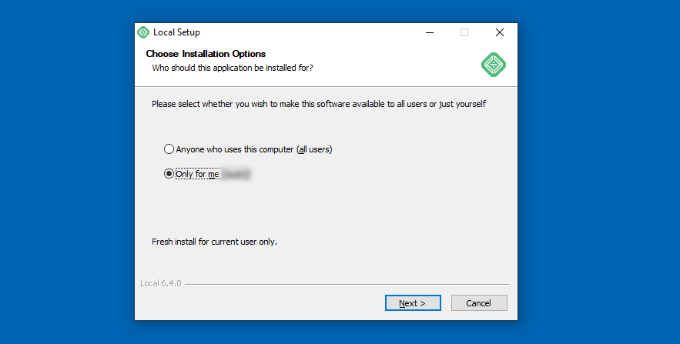
Im nächsten Schritt können Sie den “Zielordner” auswählen, in dem die Software installiert werden soll.
Klicken Sie einfach auf die Schaltfläche “Durchsuchen”, um den Pfad festzulegen, und klicken Sie dann auf die Schaltfläche “Installieren”.
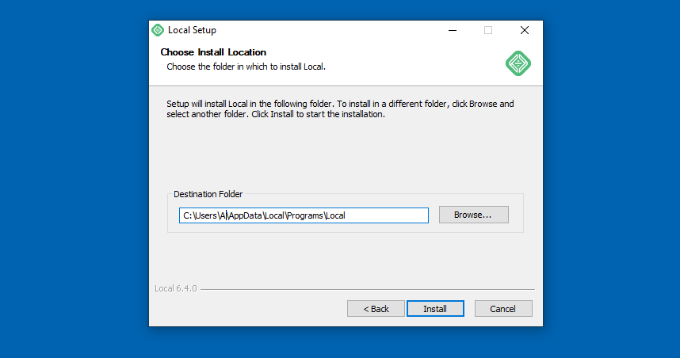
Die Local WP-Software wird nun auf Ihrem Windows-Computer installiert.
Anschließend können Sie das Kontrollkästchen “Lokal ausführen” aktivieren und im Einrichtungsassistenten auf die Schaltfläche “Fertig stellen” klicken.
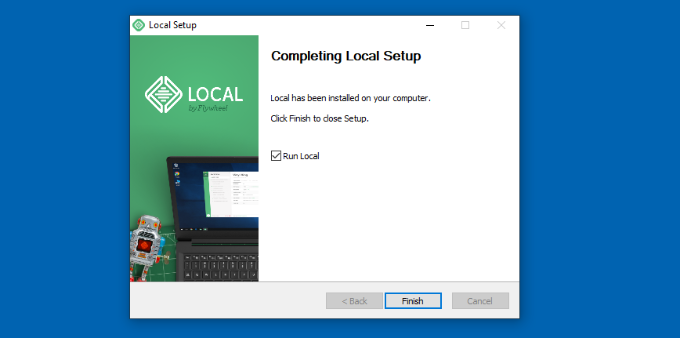
Die Software wird nun auf Ihrem Windows-Gerät gestartet.
Der nächste Schritt besteht darin, eine neue lokale Website hinzuzufügen. Klicken Sie dazu einfach auf das Pluszeichen “+” am unteren Rand.
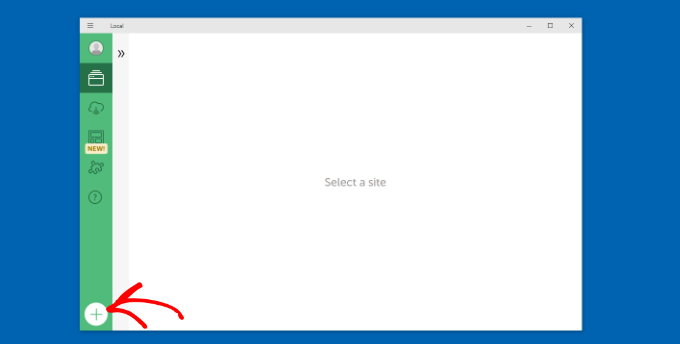
Danach können Sie eine Website in der lokalen Software erstellen.
Wählen Sie die Option “Neue Website erstellen” und klicken Sie auf die Schaltfläche “Weiter”. Es gibt auch die Möglichkeit, die Website aus einer Blaupause oder einer bestehenden Website-Datei zu erstellen, aber zur Veranschaulichung entscheiden wir uns für die erste Option.

Als nächstes können Sie einen Namen für Ihre lokale Website eingeben, z. B. “Meine WordPress-Website”.
Es gibt auch erweiterte Optionen, bei denen Sie die lokale Website-Domäne und den lokalen Website-Pfad eingeben können. Standardmäßig wird für die Domain der Titel Ihrer Website verwendet, jedoch mit Bindestrichen getrennt.
Wenn Sie fertig sind, klicken Sie einfach auf die Schaltfläche “Weiter”.

Danach müssen Sie eine Umgebung für Ihre lokale Website auswählen.
Sie können die “bevorzugte” Umgebung verwenden, in der die Software automatisch die PHP-Version, den Webserver und die MySQL-Version auswählt. Andererseits können Sie auch “Benutzerdefiniert” wählen und die Umgebungsdetails eingeben.
Local WP bietet die neuesten PHP-Versionen. Als Webserver können Sie zwischen Nginx und Apache wählen. Auch bei den Datenbanken können Sie zwischen MySQL und MariaDB wählen.
Beachten Sie, dass einige PHP-, Webserver- und Datenbankversionen das Herunterladen bestimmter Abhängigkeiten erfordern, damit sie ordnungsgemäß funktionieren.
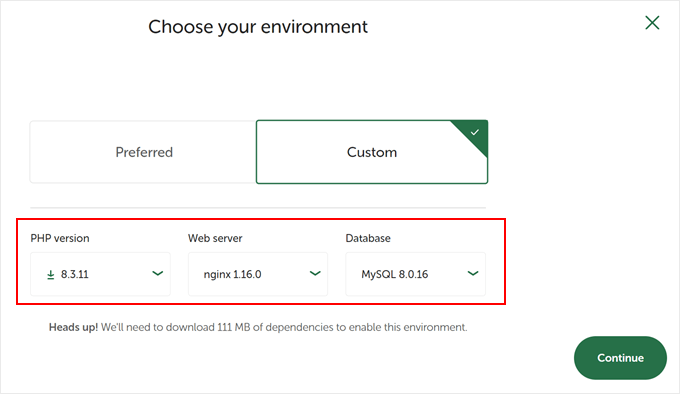
Als nächstes können Sie einen WordPress-Benutzernamen und ein Passwort für Ihre lokale Website eingeben. Außerdem haben Sie die Möglichkeit, eine WordPress-E-Mail-Adresse auszuwählen, an die Sie alle E-Mail-Benachrichtigungen erhalten werden.
Darüber hinaus gibt es eine erweiterte Option, bei der die Software fragt, ob Sie ein WordPress-Multisite-Netzwerk haben. Wenn nicht, klicken Sie einfach auf “Nein”.
Nachdem Sie diese Angaben eingegeben haben, klicken Sie einfach auf die Schaltfläche “Website hinzufügen”.
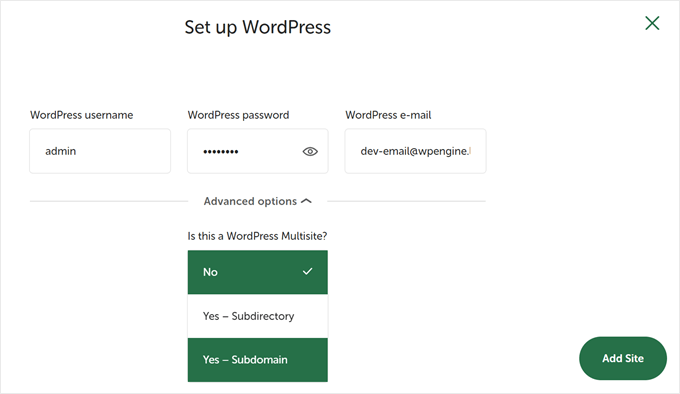
Die Software wird nun WordPress installieren und Ihre Website einrichten.
Um die lokale Website zu starten, klicken Sie auf die Schaltfläche “Website starten” in der oberen rechten Ecke.
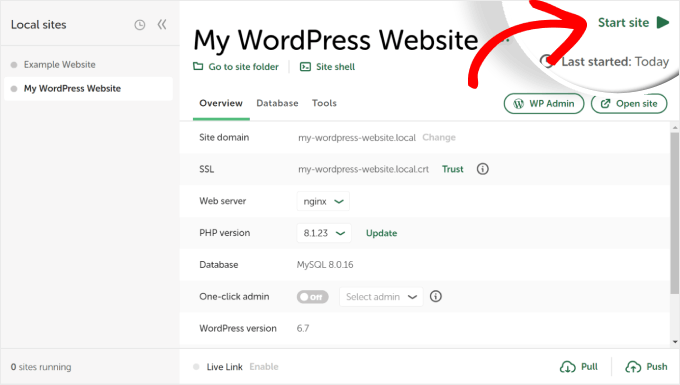
Klicken Sie als Nächstes auf die Schaltfläche “WP Admin”, um die Anmeldeseite für den WordPress-Admin anzuzeigen.
Geben Sie einfach den Benutzernamen und das Kennwort ein, die Sie zuvor bei der Einrichtung der lokalen Website eingegeben haben, und klicken Sie dann auf die Schaltfläche “Anmelden”.

Sie können nun Ihre lokale Website auf Ihrem Windows-Computer bearbeiten.
Wenn Sie fertig sind, vergessen Sie nicht, die Website von der Local WP Software zu stoppen, indem Sie auf die Schaltfläche “Stop site” klicken.
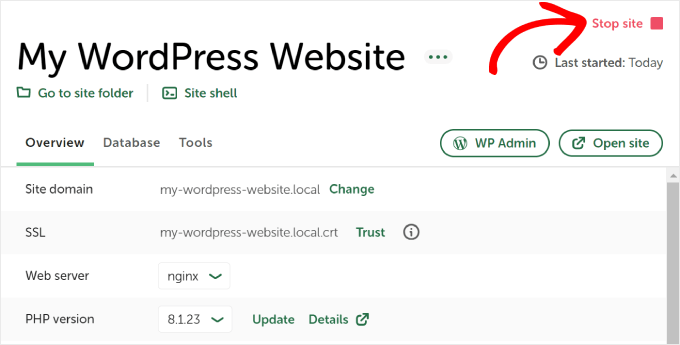
Pro-Tipp: Wenn Sie den Anmeldevorgang überspringen möchten, können Sie in Local WP einen Ein-Klick-Admin-Login aktivieren.
Gehen Sie dazu einfach zurück zum Local WP Dashboard und schalten Sie die Schaltfläche “One-click admin” auf “On”. Wählen Sie dann im Dropdown-Menü den Admin-Benutzer aus, der diese Ein-Klick-Login-Funktion nutzen kann.

Alternative: Verwenden Sie WordPress Playground, um Themes, Plugins und mehr zu testen
WordPress Playground ist ein innovatives Tool, mit dem Sie direkt in Ihrem Webbrowser mit WordPress experimentieren können. Es ist ein virtueller Sandkasten, in dem Sie neue WordPress-Themes, Plugins und Funktionen ausprobieren können, ohne eine reale Website zu beeinträchtigen.
WordPress Playground unterscheidet sich von einer lokalen WordPress-Umgebung in mehreren wichtigen Punkten.
Erstens muss es nicht auf Ihrem Computer installiert werden und wird im Gegensatz zu dauerhaften lokalen Installationen nach jeder Verwendung zurückgesetzt. Sie können von jedem Gerät mit einem Browser darauf zugreifen, während lokale Installationen an einen Computer gebunden sind.
Während WordPress Playground ideal für schnelle Tests und zum Lernen ist, bietet eine lokale WordPress-Umgebung auf Ihrem Windows-Computer mehr Flexibilität für langfristige Entwicklungsprojekte.
Eine ausführliche Anleitung finden Sie in unserem Leitfaden zur Verwendung von WordPress Playground in Ihrem Browser.
Ich habe WordPress auf meinem Windows-Computer installiert, was nun?
Jetzt, wo Sie WordPress auf Ihrem Computer haben, können Sie einige Dinge tun:
- Lernen Sie grundlegende WordPress-Tipps und -Tricks, um Ihre Website besser zu nutzen.
- Probieren Sie verschiedene WordPress-Themes aus, um zu sehen, wie Ihre Website aussehen kann.
- Installieren und testen Sie unverzichtbare WordPress-Plugins, um Ihrer Website neue Funktionen hinzuzufügen.
- Erfahren Sie, wie Sie häufige WordPress-Fehler selbst beheben können.
- Probieren Sie verschiedene Drag-and-Drop-Seitenerstellungsprogramme aus, um Ihre Website ansprechend zu gestalten.
- Erfahren Sie, wie Sie das WordPress-Administrator-Passwort auf localhost zurücksetzen, um den Zugang zu Ihrer Website wiederherzustellen.
- Richten Sie automatisierte Arbeitsabläufe ein, um die Verwaltung Ihrer Website zu erleichtern.
- Erfahren Sie mehr über die Sicherheit von WordPress, um Ihre Website vor Hackern zu schützen.
- Verschieben Sie Ihre lokale WordPress-Website auf einen Live-Server, wenn Sie sie für alle freigeben möchten.
Wir hoffen, dass dieser Artikel Ihnen geholfen hat, zu lernen, wie man WordPress lokal auf einem Windows-Computer installiert. Vielleicht interessieren Sie sich auch für unseren Artikel über die lokale Installation von WordPress auf einem Mac-Computer und unsere ultimative Anleitung zur Erstellung einer WordPress-Staging-Site.
Wenn Ihnen dieser Artikel gefallen hat, dann abonnieren Sie bitte unseren YouTube-Kanal für WordPress-Videotutorials. Sie können uns auch auf Twitter und Facebook finden.





muya chris
thank you for this article
young baykay
i thought this was to install WordPress as an app on windows not knowing its just another way of creating a WordPress site. buh i have to say that its really interesting and i learn’t something new and the whole process went well..(thumbs up)
WPBeginner Support
Glad you found it helpful, don’t forget to join us on Twitter for more WordPress tips and tutorials.
Admin
Miha
This has made my day. Thank you!
Hena
Oh!! you are awesome!! thank you very much
Abhishek sharma
Thanku very much it was very helpful.
Diego Marrs-Segura
What if you already have a WordPress account and site but you’re still required to fill in the installation form?
Jean Tildesley
Very helpful article, but when I got to setting up a database for WordPress and clicked on phpmyadmin as instructed, it opened up a localhost page with no content. Can you help please?
Regards,
Judy H
Everything installed correctly and I set up a practice web page. After working on it for awhile I left it for several days. When I attempted to log in to the WP admin site for the test web page, it wouldn’t recognize my password. Any ideas on why this happened or how to recover/reset the password?
Thanks!
Perfect ttorial
thank you very much for this perfect tutorial….all installin done…..now will try the creation
Sarah Alyea
Everything worked fantastic. Until I tried to upload the Divy theme and DivyBuilder plugin.
Received this message for both: The uploaded file exceeds the upload_max_filesize directive in php.ini.
What to do? Any advice?
tommyt
awesome post,
worked like clockwork,
thanks so much for this great post.
Tom
Zaeem Shah
your tutorial was amazing before this tutorial i didnt know about even how to download wordpress on local host after that i am able to download and the main thing is that i am able and got expert in designing a professional website by wordpress thanksss aloot u r doing good job God bless you
Shana
Followed directions and I am getting a
“No webpage was found for the web address:
http://localhost/phpmyadmin/Search Google for localhost phpmyadmin
HTTP ERROR 404
error.”
any ideas?
Shana
This problem is fixed.
Had to change the port listeners in Apache httpd.conf to port 8080.
There are 3 listeners to change.
Also must change the port preference in >Tools>Use a port other than 80.
Once clicked, it will automatically change it to 8080, or whatever port you have changed to. I suggest using 8080.
Hope this helps!
vasudevan
thanks! that helped me. you coul have also mentioned that the tools is accessed by right clicking the icon!
Bala
easy to follow the instruction, my test site on my desktop was up and running in 15 min. Thanks
WPBeginner Support
Hi Bala,
Glad to hear that Don’t forget to follow us on Facebook for more WordPress tips and tutorials.
Don’t forget to follow us on Facebook for more WordPress tips and tutorials.
Admin
Philip Venable
After Wamp installed I attempted to open phpMyAdmin and received this message in Chrome: This localhost page can’t be found
No webpage was found for the web address:
http://localhost/phpmyadminHTTP ERROR 404
Shana
try changing the port in Apache.
Claire
I am having this same error, any solutions yet please
Megha D R
It was very helpfull… The steps and links mentioned in the article are perfect….
Thank you
EIRINI TZIMA
Hello guys, great job!
I followed your advice step by step up to this point: Now open your web browser and go to http://localhost/mysite/
The WordPress database setup will start automatically.
Although the http://localhost/mysite/ seems ok and shows that
ndex of /mysite
[ICO] Name Last modified Size Description
[PARENTDIR] Parent Directory –
[DIR] __MACOSX/ 2017-03-11 22:45 –
[DIR] betheme-premium-word..> 2017-03-11 22:45 –
Apache/2.4.23 (Win32) PHP/5.6.25 Server at localhost Port 80
WordPress itself doesn’t start automatically so now i am stuck here.
Any suggestions?
Thank you so much in advance!
BR,
Eirini
Shana
I am having the same issue.
Any ideas?
Marc De Bodt
I’m also getting the same issue…
Hanif Fadilah
Really useful tutorial, exactly what i was looking for, thank you very much
Cliff
Fantastic tutorial and so easy to follow.
Now to create my test website!!
Thanks
Reg
Can I lift a WordPress site I already have, along with its theme, widgets etc, and put that onto my local computer and then process that WordPress website into another theme. My main reason for having an interest in this is that when I tried to migrate my WordPress site to a new theme it went wrong. Thankfully I had backed it up and so I could just do a restore. But I would like to move the content into a different theme.
WPBeginner Support
Hi Reg,
Yes, you can. This is one of the main reasons people install WordPress on their computers to work on their themes before it goes live. Please see our guide on how to move a live WordPress site to local server
Admin
Sirmee
Thank you so much for the good work. it was easy and straight to the point. More grease to your elbow
Stewart
Fantastic guide. Simple and easy to follow. I now have a test WP site. Many thanks
Olman
I solved my problems!
Note that my first problem was that when copying wordpress into wamp, I only copied wp-admin and not the entire wordpress folder.
The second problem (“Error establishing connection”) was the the form had auto-filled a password (“Password”) and so was actually not blank.
Olman
I am receiving the following error message:
“Error establishing a database connection”
Any advice on correcting this?
Gary
I am trying to upload a new theme from a zip file and keep getting this error “The uploaded file exceeds the upload_max_filesize directive in php.ini.” I opened the php.ini from within Wampserver php tools and changed it to 25MB but still same error. Please help
Ed
Thank you for this article. Very helpful and informational!
We want to build a WordPress-based Intranet. Is this the process for installing WordPress on a local server first, then using the All-In-One Intranet plugin after?
omar
I don’t have WAMP or anything like that, but I have apache, php and mysql installed and it worked for development like that for a while already and it works fine, but when I am trying to install WordPress 4.7.2 on step 2 i get the HTTP 500 status.
The 127.0.0.1 page isn’t working
127.0.0.1 is currently unable to handle this request.
HTTP ERROR 500
I have PHP 7.0.8.
Any thoughts?
Collins
This was helpful. But i have a problem. Anytime i tried access my dashboard (wp-admin). There is always a note. It says “Sorry you are not allowed to access this page”. I need your help to ratify the situation. Please
WPBeginner Support
Hi Collins,
First, make sure you are accessing /wp-admin/ and not a page inside wp-admin like /wp-admin/some-page.php. If the problem persists, then follow our WordPress troubleshooting guide to figure out whats causing the issue and how to fix it.
Admin
Kevin
Great Tutorial, but i have a quick question.
How would i set up a local copy of a wordpress site from a backup? ive offered to help with someones site and i want to install a copy locally which will include a ‘full’ site, webpages and database, to help make the development alot quicker than just uploading stuff to the online test server every time.
Nev Lime
This was a great help
Thank you
Pedro
When I click on phpMyAdmin, it asks for a username and password. Where do I get this information from?
Thank you.
Pedro
WPBeginner Support
Hi Pedro,
You can get this information your hosting account’s cPanel dashboard.
Admin
Lyle Peterson
Where does the installation program look for VCRUNTIME140.dll? I have it on my computer but the program won’t start because that .dll is not installed.
Alpheus
hello guys, i find it hard to download the wordpress any one with a clue pls.
sean burns
I’m stuck here-
Installing WordPress on Windows with WAMP
Download a copy of WordPress from WordPress.org. Extract the zip file and copy the wordpress folder. Go to C:\wamp\www (when I paste this to a browser nothing happens) and paste wordpress folder there. You can rename the wordpress folder to anything you want for example mysite, wpbeginner, etc.
Alexander Stevenson
I hope you solved you problem by now, but in case anyone else has an issue here’s what happened.
I highly recommend against using a browser to access that. That is specifically storage space on your computer. If you go to My Computer you should see Local Disk (C:). This is what the C:\ means. When you open the disk (by double-clicking on it) you should see a list of folders such as Program Files, Windows, and wamp. Open the wamp folder and look for a folder named www. Open that folder, and then paste the wordpress folder in it.
Martina
thanks a lottttttttt. Now I can make my web. I Love you guys.
I don’t know why people can’t help, it does not matter I’m glad I found you.
WPBeginner Support
Hi Martina,
You are welcome we are glad you find WPBeginner helpful. Don’t forget to join us on Twitter for more WordPress tips and tutorials.
we are glad you find WPBeginner helpful. Don’t forget to join us on Twitter for more WordPress tips and tutorials.
Admin
Seth Solanki
HI, I’ve installed WAMP64 and WordPress. I can add pages in WordPress but cannot edit them. I can create new pages and change themes but cannot add or edit any page content. Is this possible?
Carrie
I have a stupid question. I took a beginners wordpress class which totally sucked!
Anyway, they had me use Microsoft webmatrix instead of WAMP. The webmatrix does not work correctly. Could I install WAMP or must I now use MS webmatrix? If I do this, will I use the project I was working on for the class?
I totally lost….
Thanks
Younes Ouahrani
when i click phpmyadmin its shows that im not connected on the browser , any help guys ?
Poonam Paul
My WAMP install went smoothly and created two databases correctly. There are 2 databases and 2 config.php files in my wordpress website. The path for both databases are example.com/httpdocs/wp-config.php and example.com/httpdocs/wordpress/wp-config.php. Both databases have different DB_NAME, DB_USER, DB_PASSWORD, butDB_HOST (IP address) is same.I install httpdocs folder into the www folder properly. I enter db_host in both databases are localhost.
Now when i view the site and open localhost/wordpress/wp-admin, the error is…
This site can’t be reached…localhost refused to connect…ERR_CONNECTION_REFUSED
Gobind Singh
Thanks Sir!! You made it very clear and simple.. I have been trying to do this from a long time. But today I found this article and did it in a flash. I’m really grateful. Thanks.
WPBeginner Support
Glad you found it helpful Don’t forget to follow us on Facebook for more WordPress tips and tutorials.
Don’t forget to follow us on Facebook for more WordPress tips and tutorials.
Admin
Divine
You guys are the best..though I had issues installing my WAMPserver but I managed to fix it. Sincerely this article helped me as i was told by a friend to pay thousands of Nigeria naira before he can help me. More of these guys!!!
WPBeginner Support
Glad you found it helpful. Don’t forget to join us on Twitter for more WordPress tips and tutorials.
Admin
Anatole
You made it very clear and simple to follow. Worked a treat and I didn’t even need to watch a video online. Many thanks.
Alexander
Thanks for the effort you put into this tutorial. Finally my first wordpress test blog is running on wamp.
Geoffrey
My WAMP instal went smoothly (updated the Visial C++ packages) ..created a database called wordpress
My wordpress instal into the www folder went smoothly
When I open localhost/wordpress/wp=admin I see that the Twenty Fifteen theme is active.
But wen I view the site or sample page….I don’t see any evidence that the css of the theme has been invoked…just a very plain looking page
Yes, this is all new to me….I’ve missed something obvious I hope…what did I miss doing>
harish negi
how to test vaultpress backup in the local wordpress?
steph
hi, may i know how could actually installl phpMyAdmin? Where to get username and password to login in. Thanks
Sthe
Can I create a wp website while offline?
WPBeginner Support
Yes you can. However, you may need an internet connection to get help or check out tutorials.
Admin
Jose Luis
Hello, just thought i’d let you know that in order to access the localhost you can use root as user and leave the password field in blank.
Thanx for this article
mikmoken
Thanks for this instructions and tutorials on how to install wordpress using wamp. It helps a lot for us beginners.
WPBeginner Support
Hey mikmoken,
Glad you found it useful You may also want to subscribe to our YouTube Channel for WordPress video tutorials.
You may also want to subscribe to our YouTube Channel for WordPress video tutorials.
Admin
MelR
Thanks guys at long last and 70 years of age I’ve achieved it! Thanks to you guys cheers!!
WPBeginner Support
Hey @MeIR,
We are glad you found it useful You may also want to subscribe to our YouTube Channel for WordPress video tutorials.
You may also want to subscribe to our YouTube Channel for WordPress video tutorials.
Admin